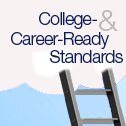As states wade into a big year for using new tests, it’s a great time to take a look at what tests they’re using and what they’re using them for.
If you follow along here regularly, you know that we’ve already covered the part about what tests they’re using. EdWeek’s own 50-state project reported on which states are using PARCC or Smarter Balanced this year, and which ones chose to use other tests. We also maintain an interactive map of all the states’ testing plans, with updates whenever a state changes its plans.

The Education Commission of the States, which maintains a powerful database of state policies on a host of education policies, waded into the question of how states are using those tests to measure college readiness. It has released a policy brief describing the college-readiness-testing landscape, and a map of the states with detailed information about how each state measures college readiness, and what actions they take based on those scores.
Achieve’s recent “Closing the Expectations Gap” report explored similar ground. With these two reports, we are getting a clearer and clearer picture of what states are—or aren’t—doing to define and respond to students’ college readiness.
Jennifer Zinth, the director of ECS’ High School Policy Center and STEM Policy Center, suggests in the policy brief that policymakers use the results of college-readiness tests to “make the senior year more meaningful.” That would involve using results to provide needed supports, interventions or advanced coursework for high school seniors. Developing policies that use scores from those tests for college admissions or course placement would be a way to “signal college readiness,” she wrote.
Relatively few states have taken any of those steps, however, according to the ECS. That leaves a key cluster of questions floating: What good is measuring college readiness if it doesn’t provide support for students who aren’t quite there, or offer additional opportunities for students who are? And what good is measuring college readiness if colleges don’t treat those scores as a sign of readiness for college-level work?
As we’ve reported to you, a few state college systems are beginning to step forward and announce that they’ll accept the college-ready cut scores on PARCC or Smarter Balanced tests as proxies for college readiness, allowing students to skip remedial work and move right into credit-bearing, entry-level courses.
There are states that have a long history of linking K-12 to higher education in these ways. California’s Early Assessment Program, for instance, gives high school juniors the option of taking an additional chunk of state test in the spring. Achieving a certain cut score whooshes them into the community colleges or the California State University system without remedial coursework. Falling below that score triggers the offering of a 12th grade bridge course designed to boost their skills.
For three years, Kentucky has been using one agreed-upon set of test scores to permit students entry into credit-bearing courses at all of its two- and four-year colleges. It also has transition courses for students who don’t meet the readiness benchmarks, and designed a data system that enables the state and districts to track whether students who need the interventions are receiving them.
Get Curriculum Matters delivered to your inbox as soon as new posts are published. Sign up here. Also, for news and analysis of issues at the core of classroom learning.
